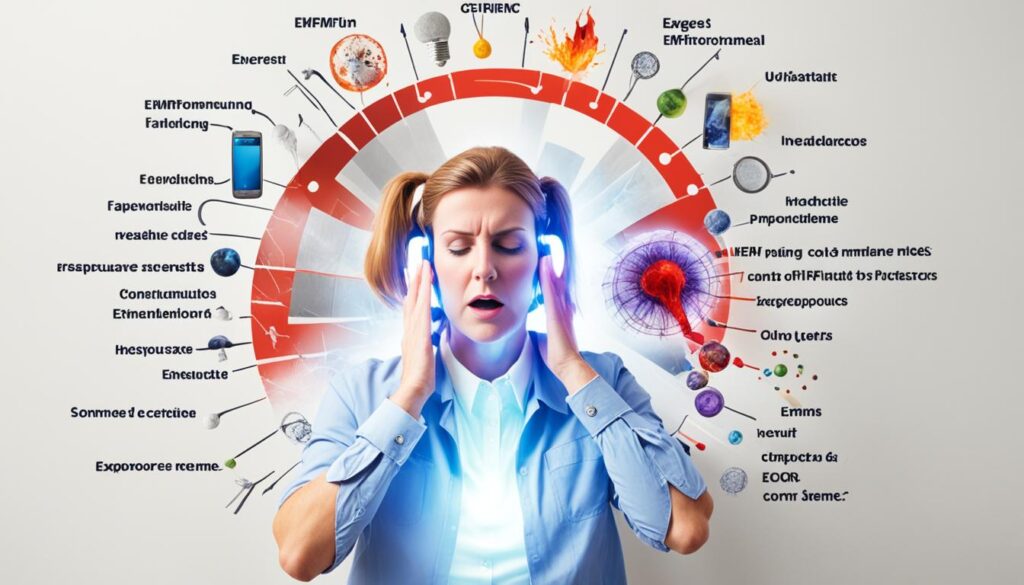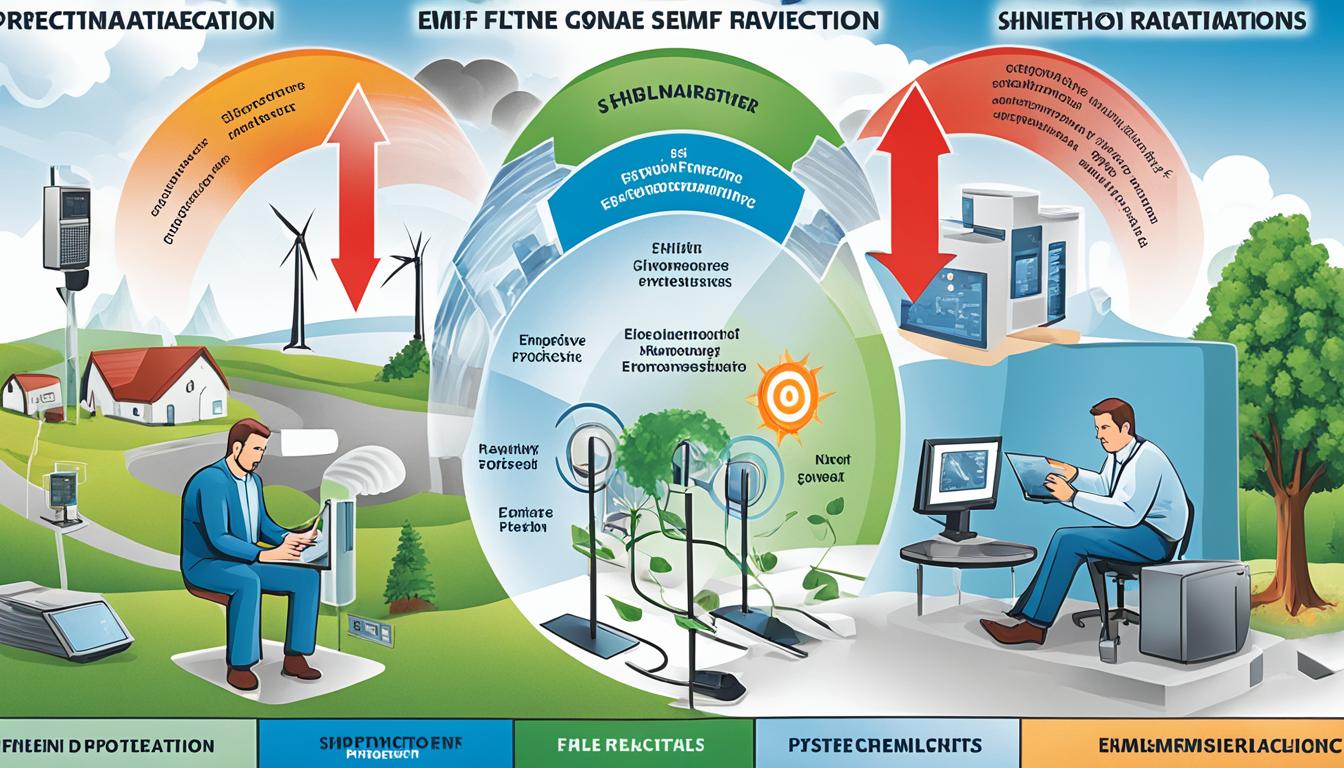Disclosure: This Post Contains Affiliate Links; We earn a commission on purchases.
In today’s modern world, we are surrounded by electromagnetic fields (EMFs) that emanate from various sources such as Wi-Fi routers, cell phones, and power lines. While the scientific evidence regarding the health risks of EMFs is inconclusive, it is essential to be mindful of our exposure and take precautionary measures to reduce potential risks.
EMF protection strategies can help mitigate our exposure to electromagnetic radiation, ensuring our well-being and peace of mind. From simple lifestyle changes to adopting innovative shielding techniques, there are numerous ways to minimize the impact of EMFs in different environments.
Key Takeaways
- Implementing EMF protection strategies can reduce your exposure to electromagnetic fields.
- Turn off Wi-Fi routers when not in use, especially during bedtime.
- Practice cell phone hygiene by using the speakerphone function or keeping your phone on airplane mode when not actively using it.
- Consider using corded landlines and Ethernet for connectivity instead of relying on wireless devices.
- Use EMF meters to monitor and assess your exposure levels.
Understanding EMFs and Their Potential Health Impacts
Electromagnetic Fields (EMFs) are the invisible energy waves that radiate from electrical power sources and light sources. They exist in two forms: non-ionizing and ionizing radiation. Non-ionizing EMFs, which are emitted by common household appliances and wireless devices, are considered weaker and have lower health risks compared to ionizing radiation from sources like X-rays and nuclear power.
While scientific evidence regarding the health risks of EMFs is inconclusive, observational studies suggest potential health problems associated with long-term exposure. The National Institute of Environmental Health Sciences acknowledges the limited evidence but recommends taking practical measures to limit exposure to EMFs.
“EMFs are a possible human carcinogen, as classified by the International Agency for Research on Cancer. However, the evidence is currently weak and more research is needed.” – National Institute of Environmental Health Sciences
To assess the levels of EMFs in your environment, you can use affordable EMF meters that measure electromagnetic frequencies. It’s crucial to maintain a distance from EMF-emitting devices like cell phones, Wi-Fi routers, and microwaves to reduce exposure to non-ionizing radiation.
Potential Health Problems linked to EMF Exposure:
| Health Problems | Potential Effects |
|---|---|
| Neurological Issues | Decreased attention, concentration, and cognitive function |
| Fertility | Potential impact on sperm count, motility, and viability in men |
| Stress Response | Increased stress response and adrenal gland impact |
| Hormonal Imbalances | Disruptions in hormonal balance and fertility issues |
| Developmental Problems | Potential impact on fetal development and child neurodevelopment |
| Increased Cancer Risk | Possible association with certain cancers, like breast cancer |
| Obesity and Diabetes | Potential links to obesity, diabetes, and oxidative stress |
While EMF exposure has been linked to these potential health problems, it’s important to note that more research is needed to establish a definitive cause-and-effect relationship. Practicing precautionary measures and reducing EMF exposure are advisable to minimize any potential health risks.
Common Health Problems Linked to EMF Exposure
Exposure to electromagnetic fields (EMFs) has been associated with a range of health problems. From fertility issues to neurodegenerative disorders, research suggests that EMF exposure can have significant impacts on our well-being.
Sperm Count and Fertility
Studies have shown a potential link between EMF exposure and male fertility. EMFs may affect sperm count, motility, and viability, potentially leading to reproductive challenges and reduced fertility in men.
Neurological Issues and Cognitive Function
Exposure to EMFs has also been associated with potential cognitive impairments. Some studies suggest that EMFs may impact cognitive function, attention, and concentration, particularly in individuals with higher exposure levels.
Stress Response and Hormonal Imbalances
Increased stress response and hormonal imbalances have been observed in individuals exposed to EMFs. EMF exposure can disrupt the body’s stress response system and lead to imbalances in hormone levels, potentially impacting overall well-being.
Developmental Problems
EMF exposure during critical developmental stages may contribute to developmental problems in children. Research has suggested a potential link between EMFs and issues such as behavioral disorders and developmental delays.
Increased Cancer Risk
While the evidence is not conclusive, some studies have suggested a higher risk of certain cancers associated with EMF exposure. Breast cancer is one of the cancers that has been studied in relation to EMFs, although more research is needed to establish a definitive link.
Obesity, Diabetes, and Oxidative Stress
There is emerging evidence that suggests a potential association between EMF exposure and health conditions such as obesity, diabetes, and oxidative stress. However, further research is required to better understand the mechanisms and extent of these relationships.
Overview of Health Problems Linked to EMF Exposure
| Health Problem | Associated Impact |
|---|---|
| Sperm Count and Fertility | Potential reduction in sperm count, motility, and viability |
| Neurological Issues and Cognitive Function | Potential impact on cognitive function, attention, and concentration |
| Stress Response and Hormonal Imbalances | Increased stress response and disruptions in hormone levels |
| Developmental Problems | Potential link to behavioral disorders and developmental delays |
| Increased Cancer Risk | Potential association with certain cancers, such as breast cancer |
| Obesity, Diabetes, and Oxidative Stress | Emerging evidence of potential links to these health conditions |
It is important to note that the research on the health impacts of EMF exposure is still evolving, and more studies are needed to establish definitive conclusions. However, these findings highlight the importance of further exploring the potential risks associated with EMFs and taking necessary precautions to minimize exposure.

Practical Tips for Reducing EMF Exposure
Implementing simple changes in daily habits can help reduce EMF exposure. By practicing mindful cell phone hygiene, increasing distance from EMF-emitting devices, and utilizing EMF protection accessories, individuals can take proactive steps to reduce potential risks and protect their health. Here are some practical tips to reduce EMF exposure:
- Practice cell phone hygiene: Keep your phone away from your body as much as possible. Use the speakerphone function, headphones, or a Bluetooth headset instead of placing the phone close to your ear. This reduces direct exposure to electromagnetic radiation.
- Increase distance from devices: Avoid prolonged exposure to EMF-emitting devices such as Wi-Fi routers, cell phones, and microwaves. Position yourself at a safe distance and maintain a minimum distance of at least one to two feet from these devices whenever possible.
- Consider using EMF protection accessories: Invest in EMF protection accessories such as phone cases, laptop shields, and EMF-blocking clothing. These accessories can help reduce exposure to electromagnetic radiation and mitigate potential health risks.
- Minimize electromagnetic pollution: Avoid unnecessary wireless devices and technologies. Turn off Wi-Fi when not in use, disable Bluetooth, and limit the use of wireless baby monitors. By reducing the number of wireless devices in your environment, you can significantly lower your overall electromagnetic pollution exposure.
- Hardwire devices: Whenever possible, opt for hardwired connections instead of relying on wireless technology. Use Ethernet cables to connect your devices to the internet and avoid prolonged wireless exposure. Hardwiring not only reduces EMF exposure but also provides a more stable and secure internet connection.
- Turn off or unplug devices when not in use: When you’re not actively using devices, especially in the bedroom, turn them off or unplug them. This helps minimize unnecessary exposure to electromagnetic radiation and creates a healthier sleep environment.
- Limit device time: Allocate time for activities that do not involve wireless technology. Engage in outdoor activities, read books, or practice hobbies that do not require the use of electronic devices. By reducing overall device usage, you can further reduce EMF exposure.
By adopting these practical tips, individuals can take control of their EMF exposure and reduce potential health risks. Remember, prudent device usage and conscious lifestyle choices can go a long way in protecting yourself from unnecessary electromagnetic pollution.

EMF Protection Accessories
| Accessory | Description | Benefits |
|---|---|---|
| EMF Phone Case | A phone case designed to block and reduce EMF radiation emitted by cell phones. | – Provides a physical barrier between the phone and the body – Reduces direct exposure to electromagnetic radiation – Easy to use and stylish design |
| Laptop Shield | A shield or pad placed under laptops to block or reduce the EMF radiation released. | – Creates a barrier between the laptop and the user – Reduces EMF exposure while using laptops – Portable and easy to use |
| EMF-Blocking Clothing | Clothing made with specially designed fabrics that block or reduce EMF radiation. | – Shields the body from electromagnetic radiation – Reduces overall exposure to EMFs – Comfortable and fashionable |
Conclusion
While the scientific evidence regarding the health risks of EMFs is inconclusive, it is important to prioritize precautionary measures in order to reduce exposure. By implementing practical tips and strategies, individuals can take proactive steps to safeguard their health in different environments.
One of the key strategies for minimizing EMF exposure is to increase the distance from EMF-emitting devices. This can be achieved by keeping cell phones away from the body, using speakerphone or headphones, and using corded landlines instead of cordless ones. Additionally, using EMF protection accessories like phone cases and laptop shields can provide an extra layer of protection.
Another effective approach is to minimize unnecessary wireless device usage and adopt wired alternatives whenever possible. This includes hardwiring devices and using Ethernet for better connectivity. Turning off or unplugging devices when not in use, especially in the bedroom, can also help reduce exposure.
By adopting these practical tips and precautionary measures, individuals can actively reduce their EMF exposure and prioritize their health and well-being. While more research is needed to establish a definitive link between EMF and health problems, taking proactive steps to minimize exposure can provide peace of mind and contribute to a healthier lifestyle.
Source Links
- https://greathealth365.com/blogs/17-ways-you-can-protect-yourself-from-emf-radiation
- https://www.amymyersmd.com/article/wifi-emf-emr
- https://drruscio.com/emf-protection/

Subscribe to Our Newsletter










